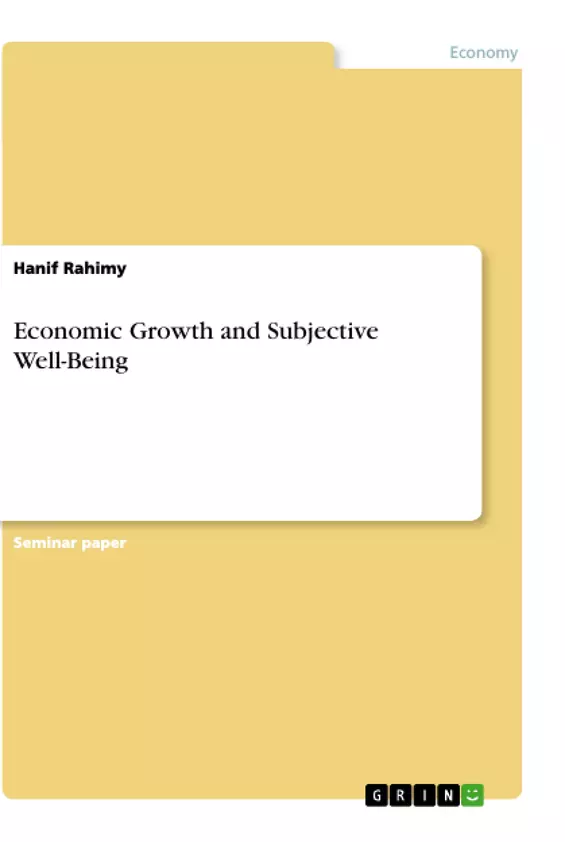This paper will examine the discourse on whether growth leads to greater life satisfaction. First, the historical data on growth and its significance are examined, and then two opposing positions on the question of whether growth brings more happiness are elaborated and analysed. In the end, we will assess to what extent we should and can orient ourselves to these findings in the future.
Growth - Navigator to happiness?
It should always go in one direction: higher, faster, further. We owe much of the technological progress of our time to this mantra. While 36% of Germans owned a smartphone in 2012, the proportion rose to over 81% in 2019. But does it always have to be more money, does the life satisfaction of a society increase when its economy grows?
This debate is certainly not new; almost every pupil should write a paper in social science class on whether the gross domestic product could be a suit-able indicator of prosperity. In recent years, the call for a new indicator of prosperity has become louder and louder. For example, the Prime Minister of New Zealand, Jacinda Ardern, announced last year that in the future she would pay more attention to the standard of living of her citizens than to economic strength alone. She justified the paradigm shift by saying that despite solid growth of 3% and an unemployment rate of 3.9%, New Zealand had a high rate of homelessness and one of the highest suicide rates. Also, 27% of children lived in poverty. Ardern is gradually changing its budget to follow the OECD's "Better Life" recommendations. Priority will now be given to government spending that strengthens mental health, pro-motes digital development and a sustainable economy, and reduces child poverty and inequalities. “This budget is a game-changing event” , says Richard Layard, Professor at the London School of Economics who is an expert on life satisfaction across populations.
The globally prevailing development model in the form of continuous economic growth is also sceptically questioned by some German economists. The president of the German Institute for Economic Research (DIW), Prof. Marcel Fratzscher, also advocates the pursuit of so-called "qualitative growth". The state should try to reduce inequality and promote climate protection through targeted investments.
Inhaltsverzeichnis (Table of Contents)
- Economic Growth - Navigator to happiness?
- What was the relationship between growth and prosperity in the past?
- Easterlin Paradox
Zielsetzung und Themenschwerpunkte (Objectives and Key Themes)
This paper explores the relationship between economic growth and subjective well-being, investigating whether increased economic growth leads to greater life satisfaction. It examines historical data on growth and its impact on social progress, analyzes two opposing positions on the link between growth and happiness, and ultimately assesses the extent to which we should and can consider these findings in the future.
- The historical relationship between economic growth and social progress.
- The Easterlin Paradox: The argument that while economic growth may lead to increased happiness in the short term, it does not correlate with long-term life satisfaction.
- The adaptability of people and how their rising aspirations can offset the initial happiness gained from increased income.
- The limitations of economic growth as a measure of prosperity and the need for alternative indicators.
- The call for a new approach to development that prioritizes well-being over economic growth alone.
Zusammenfassung der Kapitel (Chapter Summaries)
- The first chapter introduces the topic of economic growth and its relationship with life satisfaction, highlighting the growing debate surrounding the use of GDP as a sole indicator of prosperity. It examines the experiences of New Zealand and Germany, demonstrating their commitment to a broader definition of well-being.
- The second chapter delves into the historical relationship between economic growth and social progress, analyzing data on infant mortality, life expectancy, and literacy rates in various countries. It discusses the correlation between economic output and improved living standards, but also raises questions about the potential limitations of growth in the future.
- The third chapter focuses on the Easterlin Paradox, presenting Richard Easterlin's research on the relationship between income and happiness. It examines his findings, supported by data from the General Social Survey and studies across 43 countries, suggesting that while higher income may bring initial happiness, it does not guarantee long-term satisfaction.
Schlüsselwörter (Keywords)
This paper explores the key themes of economic growth, subjective well-being, life satisfaction, the Easterlin Paradox, and the limitations of GDP as a measure of prosperity. It also considers the importance of alternative indicators of well-being, including social progress, mental health, and sustainable development.
- Citar trabajo
- Hanif Rahimy (Autor), 2021, Economic Growth and Subjective Well-Being, Múnich, GRIN Verlag, https://www.grin.com/document/1022211



